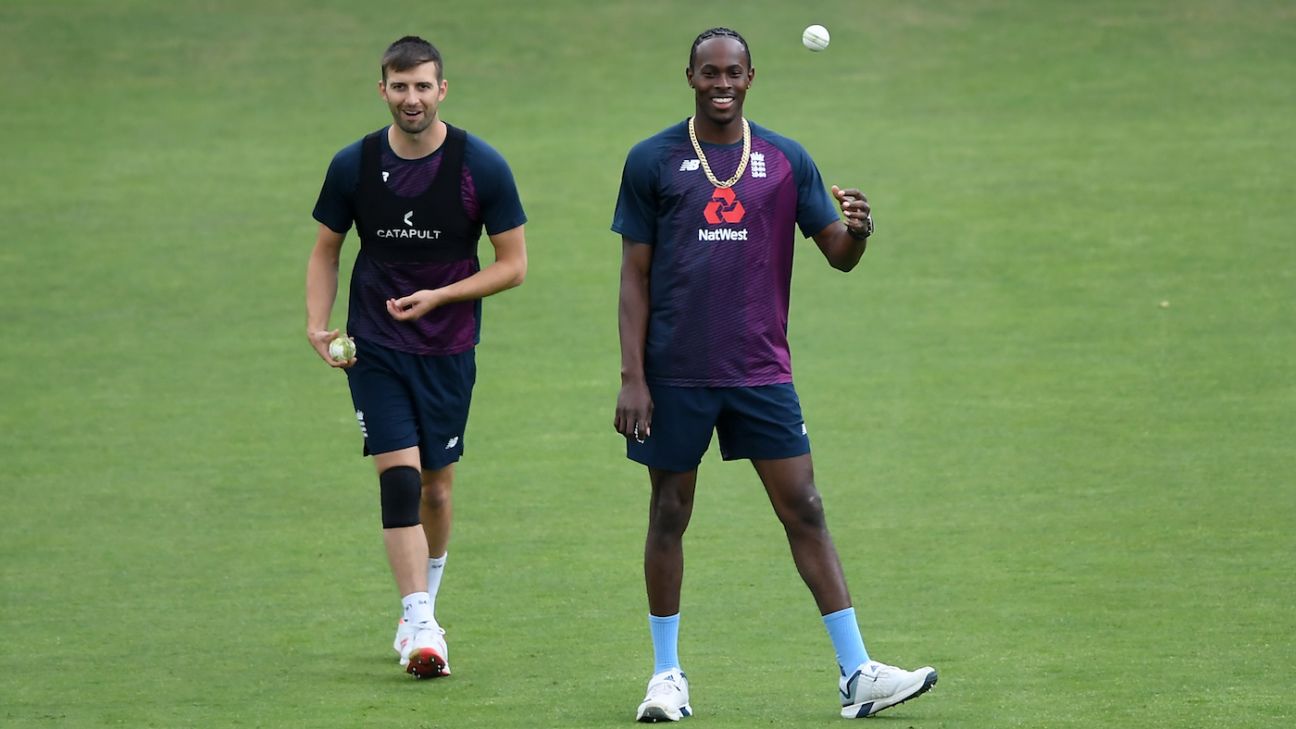
One-two barrage was shelved in South Africa but has returned with great effect in India
England’s new-ball attack had been as toothless as a pangolin heading into their T20I series in India. Across the previous 18 months, they had taken 18 wickets at an eye-watering average of 48.05 in the powerplay, all while leaking 9.30 runs per over. T20 bowling is a trade-off between attack (taking wickets) and defence (keeping scoring rates down) but England were doing neither.
But one match was the exception that proved the rule. Only once in that period had they taken three powerplay wickets, and the secret on that occasion was quite simple: pace. England paired their two fastest bowlers together and let them off the leash, with Jofra Archer passing 95mph/154kph and Mark Wood close behind in a four-over burst that had Australia’s top order ducking for cover at the Ageas Bowl as they banged the ball into the pitch at blistering speed.
It was curious, then, that the Archer-Wood combination which had worked so effectively – not only that day, but in the ODI World Cup in 2019, too – was shelved without much comment. England rotated their bowlers for the final game of the Australia series (powerplay score: 61 for 1) and then overlooked Wood throughout the three matches in South Africa at the end of last year. Across that series, England managed only four wickets in the first six overs, conceding 8.38 runs per over.
Against an Indian side packed with top-order options, this was a problem that Eoin Morgan needed to solve. He had previously tried to cover the weakness by using Tom Curran and Chris Jordan – both specialist death bowlers by trade – in the first six, but has opted to front-load with his best bowlers in this series.
The results have been clear throughout the series. While Ishan Kishan was able to get hold of Tom Curran and Jordan in Wood’s absence in the second T20I, India have managed only 22 for 3 and 24 for 3 after six overs in the two games that he has played in. It is a truism that taking three wickets in the powerplay tends to win you a T20 (after all, nobody has invented a format where early wickets are not helpful just yet) but doing so while conceding only four runs per over puts the opposition in a chokehold.
“We’ve played together so much now we just play each other’s roles,” Wood said of his partnership with Archer on Wednesday. “We enjoy playing together. It brings the best out of me as I’m sure it does out of him.
“Jofra starts a lot of the time and because he keeps the pressure on, it allows the other team to try and take risks against other bowlers. When they did try and take a risk, if we were on our game, then we got the wicket. It’s just about bowling well in tandem and trying to back each other up – keeping the pressure on for each other.”
For Wood in particular, England’s early dominance has proved beneficial during the second half of his spell in the middle overs. Generally bowling to middle-order batsmen, who tend to be stronger against spin but more vulnerable against back-of-a-length bowling at high pace, Wood has conceded only 7.12 runs per over in that phase of the game across his last five T20Is.
It is a tactic that England may employ frequently as they build towards the T20 World Cup later this year, particularly if Rashid continues to excel in the powerplay. Morgan has highlighted the trend of genuine fast bowlers coming back in vogue in white-ball cricket since the 2019 World Cup, and the prospect of having his own version of Lockie Ferguson as a ‘shock’ bowler in the middle overs is a tantalising one.
One ball he bowled on Tuesday night – a bouncer to Rohit Sharma – was clocked at 96.4mph/155.2kph, which Wood believes to be the fastest he has been clocked at in a televised game, and it has been noticeable that he is yet to change things up with a slower ball in the eight overs he has bowled. While his final over was taken apart, that owed more to Virat Kohli’s genius than to any fault on Wood’s part.
There remains one lingering doubt: Wood’s fitness. He missed the second T20I with a bruised heel – he explained it was a minor injury caused by some supporting tape sliding off and choking his feet – but his mixed injury record means that in a year which will see him in demand across formats, he will need careful management. It is a small mercy for England that he has turned down the IPL in consecutive years, rebuffing Mumbai Indians’ attempts to sign him as a replacement for Lasith Malinga before last year’s tournament and opting out of this year’s auction at the 11th hour.
“There will be a conversation at the end of this tour about what I do in the build-up to the Tests in England, obviously playing games for Durham and getting my fitness right,” he said. “I’ve done a lot of work behind the scenes on my own fitness with a strength coach.
“I’m getting myself in a good place… [but] I’d rather me charging in and bowling as quick as I can to keep my performance level up rather than being at 50-60% and not doing myself or the team justice.”
Matt Roller is an assistant editor at ESPNcricinfo. He tweets at @mroller98
